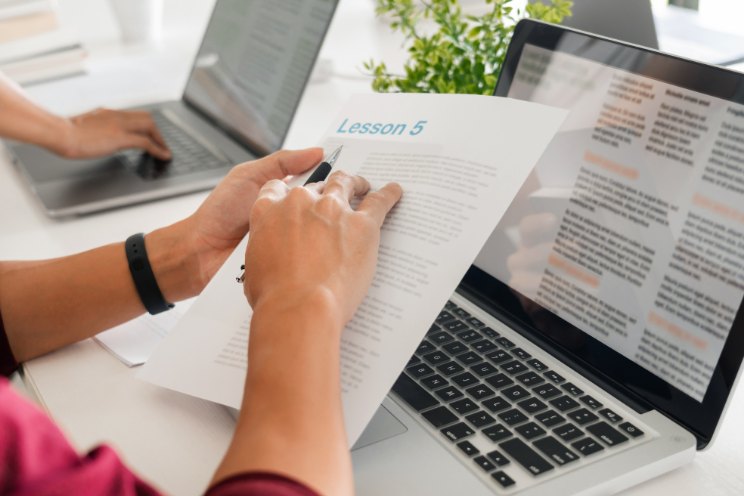Let’s get real for a second. Lesson planning is a beast. Every teacher knows it. You’re juggling curriculum standards, student needs, and the ticking clock, all while trying to inject some creativity into your lessons.
It’s exhausting. But what if there was a tool that could take some of that weight off your shoulders? Enter AI. The idea of AI writing lesson plans might sound a little futuristic, maybe even a bit scary, but trust me—it’s not science fiction.
It’s happening right now. And the question isn’t just can AI write lesson plans, but should it? And if so, how can you make it work for you?
Technology Behind AI-Generated Lesson Plans

AI isn’t just some fancy buzzword. It’s a powerful tool that’s transforming the way we approach education. At its core, AI in lesson planning uses algorithms and machine learning to analyze curriculum standards, educational goals, and student data. It processes all this information and churns out a lesson plan that’s tailored to your needs.
Think about it like this: AI is like a co-teacher that never sleeps. It’s there to help you craft a lesson plan that meets your objectives, aligns with educational standards, and—here’s the kicker—can even adapt to your students’ individual needs. It’s like having a personal assistant that does the heavy lifting, leaving you with more time to focus on what really matters: engaging with your students.
How AI Can Write Lesson Plans

So, how does AI actually go about writing lesson plans? It’s not as complicated as you might think. First, you input key information: your curriculum standards, the topics you want to cover, and any specific learning objectives. The AI then analyzes this data, using algorithms to generate a draft lesson plan that’s aligned with your goals.
Here’s a quick breakdown of the process:
- Input: You provide the AI with curriculum details, student data, and learning objectives.
- Processing: The AI uses machine learning to analyze this information, pulling from a vast database of educational content.
- Output: The AI generates a draft lesson plan, complete with activities, assessments, and even suggestions for differentiation.
The beauty of this process is that it’s customizable. You can tweak the AI-generated plan to fit your teaching style, making it a collaborative effort between you and the machine.
Example of AI written Lesson Plan
Lesson Plan: Understanding Metaphor and Simile in Literature
Subject: English Language Arts
Grade Level: 7th Grade
Duration: 50 minutes
Learning Objectives:
- Students will be able to identify and differentiate between metaphors and similes in a text.
- Students will understand how metaphors and similes enhance the meaning of a literary work.
- Students will create their own metaphors and similes to describe everyday objects or experiences.
Materials Needed:
- Whiteboard and markers
- Excerpts from selected literary works (e.g., The Outsiders by S.E. Hinton)
- Worksheets on metaphors and similes
- Projector for visual aids
Lesson Outline:
Introduction (10 minutes):
- Warm-Up Activity: Write two sentences on the board—one with a simile and one with a metaphor. Example:
- “Her smile was like sunshine” (simile).
- “Her smile was sunshine” (metaphor).
- Class Discussion: Ask students what they notice about the two sentences. Introduce the definitions of metaphor and simile, explaining that similes use “like” or “as,” while metaphors compare things directly without those words.
Direct Instruction (15 minutes):
- Explain: Use the projector to display examples of metaphors and similes from The Outsiders. Discuss how these literary devices enhance the reader’s understanding of characters or events.
- Example: “Johnny was like a frightened puppy.” (simile)
- “Life was a game.” (metaphor)
- AI Integration: Use an AI tool to generate more examples from other popular books or poems. Show students how they can easily find metaphors and similes in literature using AI tools.
Guided Practice (10 minutes):
- Worksheet Activity: Hand out worksheets where students must identify metaphors and similes from given sentences. Provide a mix of AI-generated sentences and examples from well-known literature.
- Class Review: Go over the worksheet together, asking students to share their answers and explain their reasoning.
Independent Practice (10 minutes):
- Creative Writing Activity: Ask students to write 3 similes and 3 metaphors describing something in the classroom (e.g., “The desk was as cold as ice” or “The clock was a silent judge”).
- AI Extension: For homework, suggest students use an AI-powered writing tool to enhance their creative writing, generating additional examples of metaphors or similes that they can bring to class the next day.
Conclusion (5 minutes):
- Wrap-Up Discussion: Recap the lesson by asking students how metaphors and similes contribute to the meaning of a text. Highlight that, although AI can generate examples, it’s up to them to decide when and how to use these comparisons effectively.
- Exit Ticket: Have students write down one metaphor or simile from a book they’ve read recently and share how it impacted their understanding of the text.
Assessment:
- Formative: Exit tickets and participation in discussions.
- Summative: Graded worksheet and creative writing assignment.
Benefits of Using AI for Lesson Planning

Let’s cut to the chase—why would you want to use AI for lesson planning? The most obvious benefit is efficiency. AI can handle the repetitive, time-consuming tasks that eat up your planning time, leaving you free to focus on the more creative aspects of teaching.
But there’s more:
- Personalization: AI can analyze student data to create lesson plans that cater to different learning styles and abilities. It’s like having a tool that helps you differentiate instruction without the extra workload.
- Consistency: With AI, you can ensure that your lesson plans are consistently aligned with curriculum standards. No more worrying about whether you’re hitting all the right marks.
- Support: Whether you’re a new teacher or a seasoned pro, AI can be a valuable support tool. It offers a starting point, helping you build your confidence and innovate your teaching methods.
Challenges and Limitations of AI in Lesson Planning
Now, let’s talk about the flip side. AI isn’t perfect. It’s a tool, not a magic wand, and it comes with its own set of challenges. For starters, human oversight is crucial. AI can generate a lesson plan, but it can’t interpret the nuances of your classroom environment or the unique needs of your students. That’s where you come in.
- Creativity: AI can generate content, but it’s not going to win any awards for creativity. It’s up to you to add that spark, that personal touch that makes a lesson truly engaging.
- Emotional Connection: AI can’t connect with your students on an emotional level. It’s a tool, not a teacher, and it’s your job to bring the human element to the table.
- Ethical Concerns: There’s also the issue of data privacy. When using AI, you’re dealing with student data, and it’s important to ensure that this information is handled responsibly.
The bottom line? AI is a powerful tool, but it’s not a replacement for you. It’s there to assist, not to take over.
AI vs. Human: A Comparative Analysis in Lesson Planning
Let’s break it down: AI vs. human. Which is better for lesson planning? The answer isn’t black and white. AI offers efficiency, consistency, and the ability to personalize lessons based on data. But it lacks the creativity, emotional intelligence, and adaptability that you bring to the table.
AI-Generated Lesson Plans:
- Pros: Fast, consistent, and data-driven. Great for ensuring alignment with curriculum standards and saving time on repetitive tasks.
- Cons: Lacks creativity, emotional connection, and the ability to adapt on the fly.
Human-Created Lesson Plans:
- Pros: Creative, adaptable, and emotionally resonant. You can tailor your lessons based on real-time feedback from your students.
- Cons: Time-consuming, especially when you’re trying to meet all the curriculum standards and differentiate instruction.
Here’s the sweet spot: Use AI to handle the groundwork—the heavy lifting. Then, step in and do what you do best: bring creativity, passion, and a deep understanding of your students to the final product.
Exploring AI Tools for Lesson Planning
If you’re ready to dive into the world of AI-generated lesson plans, there are some great tools out there. Here’s a quick look at a few options:
| Tool | Features | Customization Options |
|---|---|---|
| Lesson Planner AI | Generates lesson plans based on curriculum standards | Allows for adjustments in tone, style, and content |
| EduBot | Uses machine learning to adapt lessons to student needs | Customizable content blocks and assessment types |
| Classroom AI | Integrated with student data for personalized learning plans | Offers a range of templates and activity suggestions |
These tools are designed to make your life easier, not to replace you. They offer a starting point, a framework that you can build on and adapt to fit your unique teaching style.
Case Studies: AI in Action
Let’s look at a real-world example. A middle school teacher in California started using AI to help with lesson planning. At first, she was skeptical. Could a machine really understand the complexities of her classroom? But after a few weeks, she noticed a difference. The AI-generated plans were spot-on with curriculum standards, and they saved her hours of prep time each week. But the best part? She had more time to focus on her students. She could spend more time on creative activities and less time on administrative tasks.
Another example comes from a school district in Texas that implemented AI for lesson planning across multiple schools. The feedback was overwhelmingly positive. Teachers appreciated the time saved and the consistency in lesson quality. However, they all agreed on one thing: AI was a tool, not a replacement. The human element—creativity, adaptability, and emotional connection—was still essential.
The Future of AI in Education

So, what’s next for AI in education? The possibilities are endless. Beyond lesson planning, AI could revolutionize the way we assess students, manage classrooms, and even design curricula. Imagine an AI that can create personalized learning paths for each student, adapting in real-time to their progress and challenges.
But as with any technology, it’s important to strike a balance. AI should enhance education, not replace the human elements that make teaching so powerful. It’s about finding that sweet spot where technology and human creativity work together to create the best possible learning experience.
FAQs
Can AI really write effective lesson plans?
Yes, AI can generate lesson plans that are aligned with curriculum standards and tailored to student needs, but human oversight is crucial.
Is AI a replacement for teachers?
No, AI is a tool that supports teachers by handling time-consuming tasks, but it cannot replace the creativity and emotional connection that teachers provide.
What are the ethical concerns with using AI in education?
Data privacy is a major concern when using AI, as it involves handling sensitive student information. Ensuring responsible use of this data is essential.
How can I start using AI for lesson planning?
Start by exploring AI tools designed for education, and use them as a starting point for your lesson plans. Always customize the AI-generated content to fit your teaching style and the needs of your students.
Conclusion
So, can AI write lesson plans? Absolutely. But should it be the only tool in your toolbox? Probably not. AI offers incredible benefits—efficiency, consistency, and the ability to personalize lessons. But it’s not a substitute for the creativity, adaptability, and emotional intelligence that you bring to the classroom.
The best approach? Use AI to handle the heavy lifting, the repetitive tasks that drain your time and energy. Then, step in and do what you do best: connect with your students, inspire them, and bring your unique flair to every lesson. In the end, the future of lesson planning isn’t about AI taking over—it’s about you and AI working together to create something truly extraordinary.
